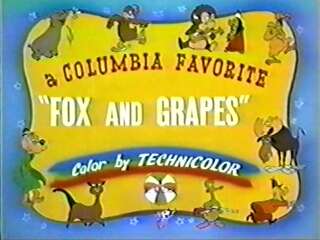Columbia Cartoons

Of all the classic theatrical animated cartoons, those released by Columbia Pictures during The Silent Age of Animation and The Golden Age of Animation are perhaps the most overlooked by the general public today. This is unfortunate because some of the most significant endeavors in the medium's history emerged from the collective works of Charles Mintz, Screen Gems and UPA. It is difficult, for example, for one to think of the history of animation without films like "The Little Match Girl", "The Fox and the Grapes", "Gerald McBoing-Boing" or "Rooty Toot Toot" that, in so many ways, redefined what a cartoon was.
While the history of Columbia's animation output is marked by hits and misses, experimentation always seems to be a constant. It was the early Charles Mintz/Screen Gems studio that produced some of the most groundbreaking cartoons of the 1930s, outside the Disney and Fleischer Studios. The Scrappy series, for example, employed exaggerated, abstract character designs and stories that involved unique personalities. The character of Scrappy, created by Dick Huemer, became an overnight success with a popularity surpassed only by Mickey Mouse.
By the late 1930s, however, things began to change. Huemer had long-since departed, Scrappy and the long-running Krazy Kat series were both fading in popularity, Disney's "Snow White" appeared in theaters, and a newer, zanier approach to animation was being developed at Warner Bros. Then, in 1939, Mintz became indebted to Columbia and lost his studio to them.
When Mintz died in 1940, his production manager, Jimmy Bronis, became his successor. After Bronis came Mintz's brother-in-law, George Winkler. Later Columbia got rid of Winkler and brought in former Disney storyman and Warner Bros. cartoon director, Frank Tashlin. Under Tashlin, the studio experienced a considerable talent boom. Many of the studio staffers were former Disney employees, fresh off the picket line from the 1941 strike at that studio. The drive to experiment and employ new, innovative ideas was strong and led to the emergence of a handful of highly-stylized cartoons as well as the successful The Fox and The Crow series, pitting a refined, sophisticated Fox against a chiseling, street-wise Crow. Unfortunately, Tashlin's stay was short-lived and he was replaced by Dave Fleischer. Later Fleischer too would depart and his other successors would make little impact on the studio. The quality of the cartoons, meanwhile, began to deteriorate and finally, in 1946, Screen Gems closed.
The void left by the closure of Screen Gems was filled by "United Productions of America" or UPA. This occurred when Steve Bosustow and his creative staff, including many alumni of Tashlin's avant-garde ensemble at Screen Gems, approached the studio. In 1948, Columbia tentatively agreed to distribute UPA's theatrical shorts, a decision that would quickly prove to be the studio's wisest, animation-wise. Throughout the late 1940s and the 1950s, UPA would earn several Academy Awards and nominations for the fruits of their efforts. In the process, they brought to the screen such endearing characters as the nearsighted Mr. Magoo (voiced by Jim Backus) and Gerald McBoing-Boing. In 1959, however, UPA ceased production of theatrical cartoon shorts and Bosustow ended up selling the studio to Henry G. Saperstein, ending the era of classic animation at Columbia.
For a History and Filmography of these films, feel free to visit the fan site "The Columbia Crow's Nest", which this page cites its description from.
Cartoon Brew has recently announced two new DVD sets, which will release many UPA oneshots and Mr. Magoo shorts. The "UPA Jolly Frolics Collection" is now available exclusively on the Turner Classic Movies online shop here, and a definitive history of the studio was compiled into a book in 2012.
Tropes:
- Animation Bump: The studio overall had a big bump after Tashlin took over, due to the influx of Disney-trained animators, then again when Columbia began releasing the UPA films.
- Limited Animation: Not just UPA, which was one of the Trope Makers, but some of the cartoons of the Tashlin regime experimented with stylized designs. Not surprising, since most of the Tashlin animators later went on to help found UPA.
- Minimalism: UPA championed a minimalist apporach to animation. Every element of production - design, color, setting, movement - was boiled down to the bare essentials.
- Remake: Ub Iwerks did a semi-remake of his earlier Disney work "The Skeleton Dance", called "Skeleton Frolic", for Columbia's "Color Rhapsodies" series.
- Short-Lived, Big Impact: United Productions of America barely lasted more than a decade as a theatrical cartoon studio, during which time their stylized approach to the medium profoundly changed the way cartoons looked for the next few decades (for better or worse). Even today, their influence, direct or indirect, is felt in shows as diverse as Dexter'sLaboratory, The Powerpuff Girls, Beavis and Butthead, Samurai Jack, Home Movies, The Simpsons and My Little Pony Friendship Is Magic.
- Wham! Episode: Even within UPA's remarkably diverse output, their adaptation of "The Tell Tale Heart" stands out.